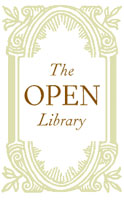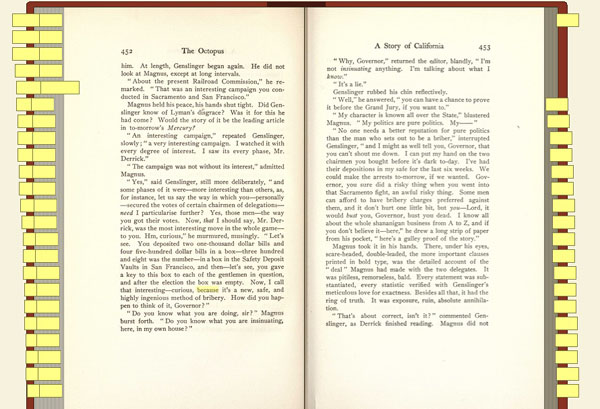 A little while back I was musing on the possibility of a People’s Card Catalog, a public access clearinghouse of information on all the world’s books to rival Google’s gated preserve. Well thanks to the Internet Archive and its offshoot the Open Content Alliance, it looks like we might now have it – ?or at least the initial building blocks. On Monday they launched a demo version of the Open Library, a grand project that aims to build a universally accessible and publicly editable directory of all books: one wiki page per book, integrating publisher and library catalogs, metadata, reader reviews, links to retailers and relevant Web content, and a menu of editions in multiple formats, both digital and print.
A little while back I was musing on the possibility of a People’s Card Catalog, a public access clearinghouse of information on all the world’s books to rival Google’s gated preserve. Well thanks to the Internet Archive and its offshoot the Open Content Alliance, it looks like we might now have it – ?or at least the initial building blocks. On Monday they launched a demo version of the Open Library, a grand project that aims to build a universally accessible and publicly editable directory of all books: one wiki page per book, integrating publisher and library catalogs, metadata, reader reviews, links to retailers and relevant Web content, and a menu of editions in multiple formats, both digital and print.
Imagine a library that collected all the world’s information about all the world’s books and made it available for everyone to view and update. We’re building that library.
The official opening of Open Library isn’t scheduled till October, but they’ve put out the demo now to prove this is more than vaporware and to solicit feedback and rally support. If all goes well, it’s conceivable that this could become the main destination on the Web for people looking for information in and about books: a Wikipedia for libraries. On presentation of public domain texts, they already have Google beat, even with recent upgrades to the GBS system including a plain text viewing option. The Open Library provides TXT, PDF, DjVu (a high-res visual document browser), and its own custom-built Book Viewer tool, a digital page-flip interface that presents scanned public domain books in facing pages that the reader can leaf through, search and (eventually) magnify.
Page turning interfaces have been something of a fad recently, appearing first in the British Library’s Turning the Pages manuscript preservation program (specifically cited as inspiration for the OL Book Viewer) and later proliferating across all manner of digital magazines, comics and brochures (often through companies that you can pay to convert a PDF into a sexy virtual object complete with drag-able page corners that writhe when tickled with a mouse, and a paper-like rustling sound every time a page is turned).
This sort of reenactment of paper functionality is perhaps too literal, opting for imitation rather than innovation, but it does offer some advantages. Having a fixed frame for reading is a relief in the constantly scrolling space of the Web browser, and there are some decent navigation tools that gesture toward the ways we browse paper. To either side of the open area of a book are thin vertical lines denoting the edges of the surrounding pages. Dragging the mouse over the edges brings up scrolling page numbers in a small pop-up. Clicking on any of these takes you quickly and directly to that part of the book. Searching is also neat. Type a query and the book is suddenly interleaved with yellow tabs, with keywords highlighted on the page, like so:

But nice as this looks, functionality is sacrificed for the sake of fetishism. Sticky tabs are certainly a cool feature, but not when they’re at the expense of a straightforward list of search returns showing keywords in their sentence context. These sorts of references to the feel and functionality of the paper book are no doubt comforting to readers stepping tentatively into the digital library, but there’s something that feels disjointed about reading this way: that this is a representation of a book but not a book itself. It is a book avatar. I’ve never understood the appeal of those Second Life libraries where you must guide your virtual self to a virtual shelf, take hold of the virtual book, and then open it up on a virtual table. This strikes me as a failure of imagination, not to mention tedious. Each action is in a sense done twice: you operate a browser within which you operate a book; you move the hand that moves the hand that moves the page. Is this perhaps one too many layers of mediation to actually be able to process the book’s contents? Don’t get me wrong, the Book Viewer and everything the Open Library is doing is a laudable start (cause for celebration in fact), but in the long run we need interfaces that deal with texts as native digital objects while respecting the originals.
What may be more interesting than any of the technology previews is a longish development document outlining ambitious plans for building the Open Library user interface. This covers everything from metadata standards and wiki templates to tagging and OCR proofreading to search and browsing strategies, plus a well thought-out list of user scenarios. Clearly, they’re thinking very hard about every conceivable element of this project, including the sorts of things we frequently focus on here such as the networked aspects of texts. Acolytes of Ted Nelson will be excited to learn that a transclusion feature is in the works: a tool for embedding passages from texts into other texts that automatically track back to the source (hypertext copy-and-pasting). They’re also thinking about collaborative filtering tools like shared annotations, bookmarking and user-defined collections. All very very good, but it will take time.
Building an open source library catalog is a mammoth undertaking and will rely on millions of hours of volunteer labor, and like Wikipedia it has its fair share of built-in contradictions. Jessamyn West of librarian.net put it succinctly:
It’s a weird juxtaposition, the idea of authority and the idea of a collaborative project that anyone can work on and modify.
But the only realistic alternative may well be the library that Google is building, a proprietary database full of low-quality digital copies, a semi-accessible public domain prohibitively difficult to use or repurpose outside the Google reading room, a balkanized landscape of partner libraries and institutions left in its wake, each clutching their small slice of the digitized pie while the whole belongs only to Google, all of it geared ultimately not to readers, researchers and citizens but to consumers. Construed more broadly to include not just books but web pages, videos, images, maps etc., the Google library is a place built by us but not owned by us. We create and upload much of the content, we hand-make the links and run the search queries that program the Google brain. But all of this is captured and funneled into Google dollars and AdSense. If passive labor can build something so powerful, what might active, voluntary labor be able to achieve? Open Library aims to find out.

be said:
> but in the long run we need interfaces that
> deal with texts as native digital objects
> while respecting the originals.
very well put.
-bowerbird
The potential for The Open Library seems tremendous, but I find the multiple manifestations of texts troubling. If, as in their built-in example of Tom Sawyer, a search yields 130 different editions of a single work, which one will a user go to? It seems to me that the whole system must be constructed around the core texts rather than the individual editions of those texts. The library should still collect information on all editions (print, audio, electronic and foreign language included) but I can’t see any reason why those should be the primary nodes of data.
I agree this is very cohesive and graceful evaluation of library content posting.
The book content engines will continue to self define as wonderful bibliographic utilities….to print collections. The innovative way forward is to elaborate and refine these utilities until they can effectively track and query the discrete print book content. The other factor is innovative reliance on the print book going forward. Build on the print book functionality as it exists, build on the screen utilities as they can be realized and leverage the attributes of both as a merged expressive, transmission medium.
A neat realization of the bibliographi utility precept is at Exbiblio.
The Open Library concept is unique in the sense that it covers every part of Human-Auto Interactions. As truly , the Google aspect is on the Revenue customers not the Readers and users, I hope Open Library could turn the table and face the User and the Reader with much broader and clear page
As we all know, Google’s interests go beyond the academic, the intellectual, or the altruistic. Since it has the money to alter policy in a place like Washington, where money really talks, Google is positioning itself to set the conditions for the next generation of mobile telephones and wireless Internet use. Their willingness to bid up to $4.6 billion for a portion of the nation’s airwaves that will be auctioned next year clearly demonstrates this. Their push towards an open network is of course aimed at creating as many consumers of their online advertising as possible.
It is indicative of our times to see how libraries, the last repository of the intellect, are increasingly falling for this commercially motivated system. The card catalog has always been the first step for those looking for information in and about books, and a networked one is a great resource. Building an open source library catalog is indeed a mammoth undertaking, and the Open Library is willing to take the task on. And yes, the idea of authority and the idea of a collaborative project can coexist when presented as an open invitation to the librarianship community: geeks, librarians and booklovers. On the other hand, the Open Library’s intent of using engineer concepts of external search engines to provide book recommendations instead of advertisement, does present the reader with a true virtual librarian.
Unfortunately, while Mickey Mouse continues to rule public domain we won’t be able to digitally flip the pages of many, many books. (Sorry Ben, but I did love “leafing” through one of the British Library’s volumes of Alice’s Adventures Underground at Lewis Carroll’s show at the International Center of Photography a few years ago. This one, a large monitor set on a bookstand, gave me the feeling of actually handling the original Alice, minus the olfactory sensation.) I suspect that these “book avatars” will have to have their shelf space in the library of the future along with their native digital counterparts. Sort of the future’s incunabula. It is the browsing, an essential element of the catalog, in particular the “faceted browsing,” which really transcends the physicality of books.
I hear you Sol, and don’t get me wrong, the British Library’s facsimiles are exquisite. With something like Alice, or DaVinci’s notebooks, or Vesalius’ De humani corporis fabrica you are dealing with a rare manuscript that the vast majority of people on the earth will never have the opportunity to handle. Since the physical properties of these books are so intimately tied to their contents, not to mention their history, striving for faithful, tactile reproduction makes perfect sense, and as you testify, the encounter can be very meaningful (a revelation in fact). But these works are a special subset of the global library. For fully interactive digital textuality, we will need to devise new forms and processes. So I wouldn’t label the British Library’s interface as digital incunabula, but I think the Open Library’s imitation of it certainly qualifies.